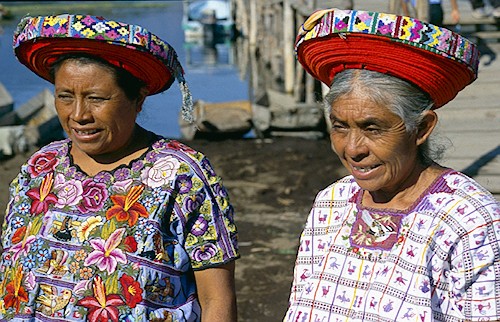LUXURY TRAVEL: Guatemala
Luxury choices are slim. We include this destination for the luxury of exploration. In Guatemala City we suggest The Westin Camino Real near Tikal. In La Antigua Posada del Angel. Is a charming guest house but not the height of luxury. Near Tikal, La Lancha on the shores of Lake Peten is Hollywood film director Francis Ford Coppola's eco-lodge . A charming thatched bure choice but not conventionally five star. One of a trio of Coppola nature-based hotels in Central America which also includes Blancaneaux Lodge and Turtle Inn in Belize. (Coppola productions also include the Z hotels Jardin Escondido in Buenos Aires and the private7-bedroom house, 714 Gov. Nicholls Street in New Orleans.)
|
When you come to a fork in the road - take it. Yogi Berra
|

|
More Articles
- 48 Hours in Charnwood
- Aruba, Dutch Caribbean
- Blowfish in Toyko
- bluboho x St. Kitts
- Boracay, Philippines
- CONCIERGE CHOICE: Best of Shanghai
- Darjeeling, India
- DRESSING FOR A... Luxury Resort Holiday
- DRESSING FOR AN... Afternoon Sightseeing
- Editor's Choice
- FAMILY LUXURY: South Africa Safari
- Footsteps of Lovers
- Franz Josef Glacier, South Island, New Zealand
- Future Luxe
- GOURMET TRAVEL: Top 10 Restaurants in Wan Chai
- Gujarat, India
- Helicopters over New Zealand
- Highway to the danger zone
- I ALWAYS TRAVEL WITH... Playing Cards
- JUST UNPACKED FROM... Chichen Itza, Mexico
- Kakadu, NT, Australia
- Kenya, Africa
- Lisbon, Portugal
- LUXURY ADVENTURE: Mount Pinatubo's Volcano Climb, The Philippines
- LUXURY AIR TRAVEL: Air Asia X
- Luxury Hotels in Luang Prabang
- LUXURY LOVES... Instagram
- LUXURY LOVES... Where I'd Rather Be
- LUXURY OPINION: Mini Bars
- LUXURY OPINION: Why Do Luxury Hotels Charge for WiFi?
- LUXURY PLANE: An A380 of your own
- LUXURY TRAVEL GUIDE: Amsterdam
- LUXURY TRAVEL: Voyage to the Future
- LUXURY TRAVEL: 7 Best Travel Books of All Time
- LUXURY TRAVEL: A Segway in Bali
- LUXURY TRAVEL: Aboard the British Pullman
- LUXURY TRAVEL: Africa
- LUXURY TRAVEL: Ama Divers, Ise Shima, Japan
- LUXURY TRAVEL: Ambroise - Artbnb
- LUXURY TRAVEL: Antarctic
- LUXURY TRAVEL: Astra Lodge & Skimetric Academy
- LUXURY TRAVEL: Bay of Fires Lodge, Tasmania, Australia
- LUXURY TRAVEL: Brighton i360
- LUXURY TRAVEL: Brittany, France
- LUXURY TRAVEL: Bucket List 2016
- LUXURY TRAVEL: Celebrate NYE twice
- LUXURY TRAVEL: Chateaux of the Loire, France
- LUXURY TRAVEL: Corsica, France
- LUXURY TRAVEL: Courchevel, France
- LUXURY TRAVEL: Deer Valley
- LUXURY TRAVEL: Destination Weddings
- LUXURY TRAVEL: Devon Driving
- LUXURY TRAVEL: Egypt
- LUXURY TRAVEL: Elephants in Thailand
- LUXURY TRAVEL: February 2019
- LUXURY TRAVEL: Female Travel in the Maldives
- LUXURY TRAVEL: Field of Light
- LUXURY TRAVEL: Finland
- LUXURY TRAVEL: Formula 1 Circuits
- LUXURY TRAVEL: Four Seasons' New Bed
- LUXURY TRAVEL: French Canals
- LUXURY TRAVEL: Galapagos Islands
- LUXURY TRAVEL: Guatemala
- LUXURY TRAVEL: Hotel Service
- LUXURY TRAVEL: Hvar, Croatia
- LUXURY TRAVEL: Indian Pacific
- LUXURY TRAVEL: INLE LAKE, MYANMAR
- LUXURY TRAVEL: Is hedonism really back?
- LUXURY TRAVEL: James Street, Brisbane
- LUXURY TRAVEL: Kerala, India
- LUXURY TRAVEL: Loire Valley, France
- LUXURY TRAVEL: Losinj Island, Croatia
- LUXURY TRAVEL: Love Letters
- LUXURY TRAVEL: Lumiere London, London’s West End
- LUXURY TRAVEL: Luxe Names
- LUXURY TRAVEL: Manta Ray Conservation
- LUXURY TRAVEL: Mie Prefecture, Japan
- LUXURY TRAVEL: MONA (Museum of Modern Art), Tasmania
- LUXURY TRAVEL: Moscow
- LUXURY TRAVEL: Most Instagrammed Locations
- LUXURY TRAVEL: Mount Perisher, Australia
- LUXURY TRAVEL: Mykonos, Greece
- LUXURY TRAVEL: New Orleans
- LUXURY TRAVEL: New York
- LUXURY TRAVEL: Nomadic Luxury
- LUXURY TRAVEL: NORWAY
- LUXURY TRAVEL: Okavango Delta, Botswana
- LUXURY TRAVEL: Oman
- LUXURY TRAVEL: Patagonia, Chile
- LUXURY TRAVEL: Peru
- LUXURY TRAVEL: Petra, Jordan
- LUXURY TRAVEL: Pia Muehlenbeck
- LUXURY TRAVEL: Queenstown, NZ
- LUXURY TRAVEL: Renew your Honeymoon
- LUXURY TRAVEL: Royal Ascot
- LUXURY TRAVEL: Rwanda Gorillas
- LUXURY TRAVEL: Santiago, Chile
- LUXURY TRAVEL: Singapore Grand Prix Guide
- LUXURY TRAVEL: Ski South America
- LUXURY TRAVEL: Sole & Mare, Turkey
- LUXURY TRAVEL: St Petersburg
- LUXURY TRAVEL: Stay like a Royal
- LUXURY TRAVEL: Stopping Plastic Pollution
- LUXURY TRAVEL: Suitcase Psychology
- LUXURY TRAVEL: Switzerland
- LUXURY TRAVEL: Sydney Seaplanes
- LUXURY TRAVEL: Syria
- LUXURY TRAVEL: The Arctic
- LUXURY TRAVEL: The Atacama
- LUXURY TRAVEL: The Great Bed Wars
- LUXURY TRAVEL: The Great Migration
- LUXURY TRAVEL: The Nile, Egypt
- LUXURY TRAVEL: 'THIS IS BARBIE'
- LUXURY TRAVEL: Tokyo Tsukiji Fish Market, Japan
- LUXURY TRAVEL: Travel Hacks
- LUXURY TRAVEL: Turkey
- LUXURY TRAVEL: Uzbekistan's Silk Road
- LUXURY TRAVEL: Val Thorens, France
- LUXURY TRAVEL: Valparaiso, Chile
- LUXURY TRAVEL: Walking in Victoria
- LUXURY TRAVEL: Wedding Dress Chronicles
- LUXURY TRAVEL: West Virginia, USA
- LUXURY TRAVEL: Winter in Zurich
- LUXURY TRAVEL: World’s Most Popular Beaches
- LUXURY TRAVEL:Golf for beginners, Sicily
- LUXURY TRAVEL:Paphos, Cyprus
- Morocco
- New Zealand Ski
- Oaxaca, Mexico
- Off-road adventure - Moreton Island, Australia
- On Location
- OPEN PASSPORT: Phil Keoghan
- OPEN PASSPORT: Tom Keneally
- Palm Springs, California, USA
- Papua (Irian Jaya), Indonesia
- Paris, the city the world wants to be
- PNG - The spirits of the Sepik
- Restaurants of the Skies
- Shanghai, China
- Ski Season Chic
- Skiing in Canada
- St Tropez
- Suite Eats
- Tasmania - A new state of Luxury
- Telluride
- The Rise of Noctourism
- The Seven Wonders of Vanuatu
- The Travel Mum's Holiday Booking Tips
- Top Ferrari Tours
- Top-10-Luxury
- WHAT TO PACK... Bask + Groove
- WHAT TO PACK... Stylish Holiday
- WHAT TO PACK... Wilderness x Sealand






